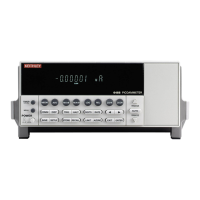Model 6485 Picoammeter Instruction Manual Remote Operation 9-15
Program Message Terminator (PMT)
Each program message must be terminated with an LF (line feed), EOI (end or identify),
or an LF+EOI. The bus will hang if your computer does not provide this termination. The
following example shows how a program message must be terminated:
:trac:poin 10 <PMT>
Command execution rules
• Commands execute in the order that they are presented in the program message.
• An invalid command generates an error and, of course, is not executed.
• Valid commands that precede an invalid command in a multiple command program
message are executed.
• Valid commands that follow an invalid command in a multiple command program mes-
sage are ignored.
• For fastest command execution:
1. Do not use optional command words (i.e., [:SENSE [1]]).
2. Do not use the colon (:) at the beginning of a program message.
3. Always use the short-form versions of commands and parameters.
4. Minimize the amount of “white” space in command strings.
5. Keep numeric parameters simple (i.e., 1 vs. 1.000e + 00).
6. Use all upper-case.
Response messages
A response message is the message sent by the instrument to the computer in response to a
query command program message.
Sending a response message
After sending a query command, the response message is placed in the output queue.
When Model 6485 is addressed to talk, the response message is sent from the output
queue to the computer.
Multiple response messages
If you send more than one query command in the same program message (see “Multiple
Command Messages”), the multiple response messages for all the queries is sent to the
computer when Model 6485 is addressed to talk. The responses are sent in the order that
the query commands were sent and are separated by semicolons (;). Items within the same
query are separated by commas (,). The following example shows the response message
for a program message that contains four single item query commands:
0; 1; 1; 0

